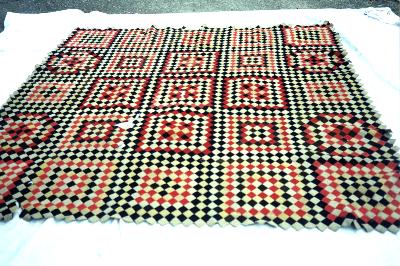Quilt No.508JR - Name withheld

1350 x 1350mm
The quilt was left to the present owner by Miss Willis, a friend. A note was pinned to it "This rug was made by wounded soldiers from the Crimean war who, being destitute, cut up their uniforms and made them into rugs which were sold to benefit the men." Miss Willis died in 1977 in Burnie Tasmania.
The present owner's family lived close to Miss Willis for many years. She had only one brother who died long before her and no children. The owner writes: "She was a very clever woman with a huge variety of craft-work. I was an only child and when I was a little girl she made me the most beautiful doll's clothes and blankets and sheets for my doll's cradle, frilled pillowslips with lemon bows and later she made me a huge wardrobe of clothes for my teenage doll collection. They are so beautiful and detailed. She was a very clever needle-worker. She was also a keen gardener with a great knowledge of plants. She was also a very talented painter. We have 5 of her paintings framed now. They were painted in the 1920s. When I was little Miss Willis wrote me several short stories and illustrated them and made them into books for me. They featured my pet cat and her pet cat.
Miss Willis' great, great grandfather settled in Van Diemans Land in the 1820s with his family and built a fine Georgian home near Campbelltown. I have absolutely no idea from which side of her family the quilt came from, but recently I read in a Tasmanian history book that when called upon to help financially after the Crimean war, Tasmanians responded very well - so maybe it was then that the quilt arrived in the family - however if this is the case it doesn't answer why it has never been lined and padded. (It is the top only.)." [Quilt owner 4.3.1997]
Related Quilts:
1270 x 950mm
1829 x 1829mm
2170 x 1880mm






